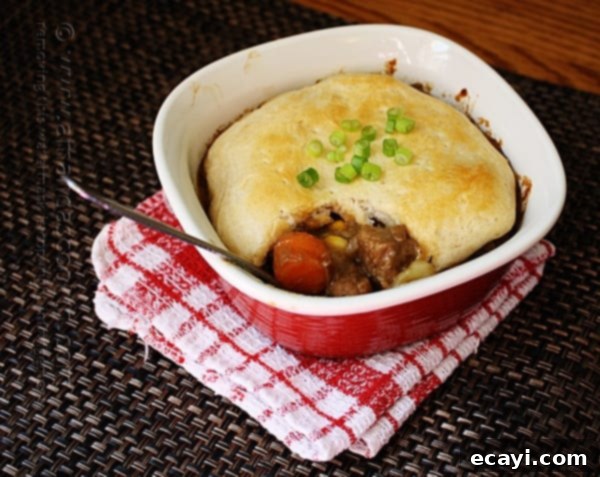Hearty Homemade Beef Stew Biscuit Pot Pie: A Soul-Warming One-Dish Meal
There’s a certain magic that comes with a classic pot pie, a comforting dish that many of us grew up cherishing. For me, those memories often involve the convenient, freezer-to-oven variety. While those are nostalgic, nothing truly compares to the rich, deep flavors of a homemade beef stew. The only challenge? A hearty stew almost always begs for something to soak up its delicious gravy – a fluffy dinner roll or a warm biscuit. So, I embarked on a culinary quest to combine these two beloved comfort foods into a single, incredibly satisfying dish: the Beef Stew Biscuit Pot Pie. It offers all the robust flavor of a slow-cooked beef stew, topped with a golden, flaky biscuit crust, and the best part is, it’s significantly faster and less fuss than wrestling with pie dough for a traditional pot pie. This innovative approach delivers maximum comfort with minimal effort, making it a perfect addition to your family dinner rotation.
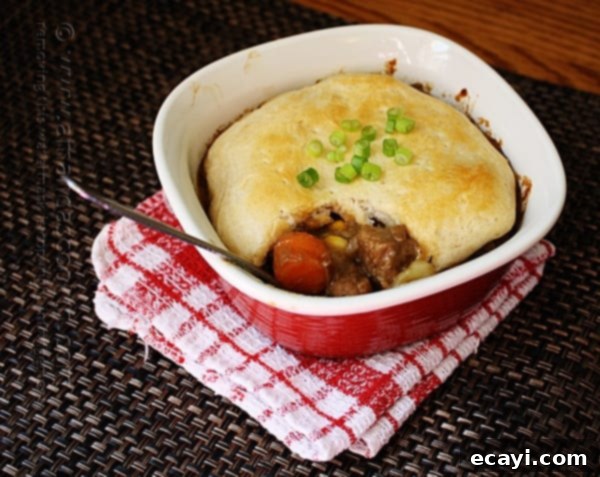
Now, here’s a little confession that might surprise you: despite my love for the concept of a biscuit topping, I’ve never been a huge fan of biscuits on their own. Dinner rolls? Absolutely. But biscuits typically felt a bit too crumbly or heavy for my preference. I can almost hear the collective gasp! However, a few years ago, I discovered a game-changing trick that transformed my entire perspective on biscuits, especially when used in a savory context like this pot pie. The secret? Flattening them. Yes, I know, it sounds counterintuitive to everything you’re taught about achieving light, fluffy biscuits. But for this specific application, flattening the biscuit dough before placing it atop the stew creates a wonderfully crisp, golden crust that acts as the perfect lid, absorbing just enough of the stew’s juices without becoming soggy. It’s the ideal textural contrast to the tender meat and vegetables below, and it makes all the difference in achieving that ultimate comfort food experience.
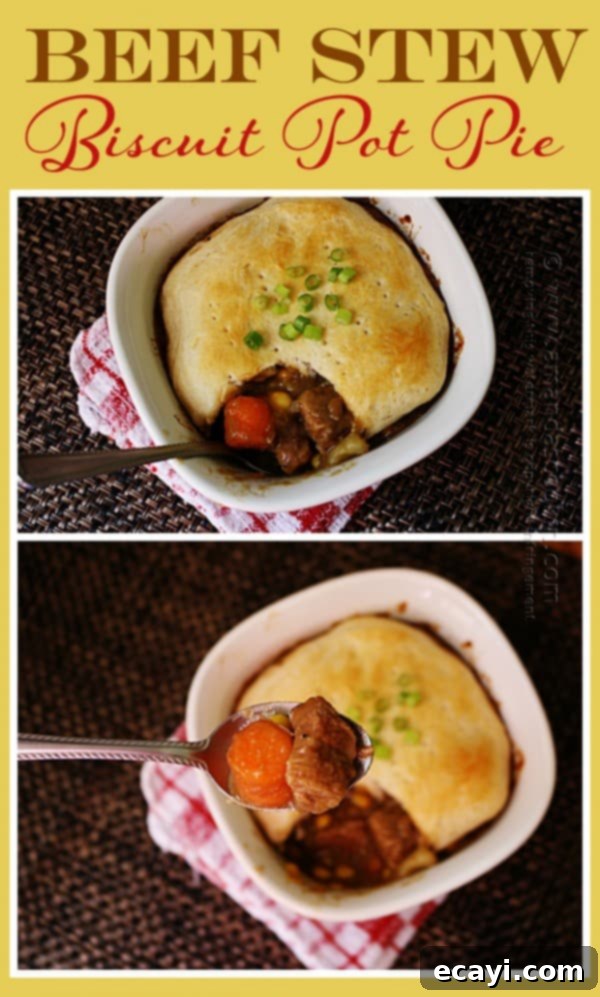
Embracing the Charm of Beef Stew Biscuit Pot Pie
The concept of baking biscuits on top of a casserole isn’t new; in fact, it’s often referred to as a “bubble up” casserole. Traditionally, this method involves layering many biscuits across a large 13×9 inch baking pan, creating a unified, bubbly crust. Our Beef Stew Biscuit Pot Pie takes this beloved technique and refines it, transforming it into elegantly portioned, individual servings. This individualized approach makes it ideal for dinner parties, meal prepping, or simply enjoying a cozy meal for one without the temptation of an entire casserole. Each small pot pie provides a perfectly balanced meal, complete with succulent beef, tender vegetables, and that irresistible, flattened biscuit topping.
Why You’ll Fall in Love with This Recipe
- Effortless Comfort: Skip the fuss of traditional pie crusts and enjoy the simplicity of canned biscuits. It significantly cuts down on prep time without sacrificing flavor or texture.
- Individual Perfection: Serving in individual ramekins makes for a charming presentation and ideal portion control. No more fighting over the last slice!
- Rich, Deep Flavors: Our stew recipe is crafted to deliver layers of savory goodness, from perfectly browned beef to aromatic herbs and a secret ingredient that enhances the depth.
- Highly Customizable: Easily adjust the vegetables to your family’s favorites or what you have on hand.
- Perfect for Any Occasion: Whether it’s a chilly weeknight dinner or a casual gathering with friends, this pot pie is always a hit.
If you’re ready to create a meal that evokes warmth and satisfaction with every spoonful, then this Beef Stew Biscuit Pot Pie is exactly what you need. It’s a testament to how simple ingredients can come together to create something truly extraordinary.
Ingredients You’ll Need for Your Delicious Pot Pies
Gathering your ingredients is the first step to creating this heartwarming dish. We’ve carefully selected a combination of pantry staples and fresh produce to ensure a rich, flavorful stew that pairs perfectly with our biscuit topping. Remember, quality ingredients make all the difference, so opt for fresh vegetables and good quality stew meat.
- 2 lbs beef stew meat
- 1/4 cup flour
- 1/2 teaspoon sea salt
- 1/4 teaspoon freshly ground black pepper
- 1/2 teaspoon dried thyme
- 2 tablespoons olive oil
- 1/2 cup brewed coffee
- 2 cups beef broth
- 1 cup water
- 2 cups chopped potatoes
- 1 cup chopped carrots
- 1 cup sliced mushrooms
- 1 can large biscuits
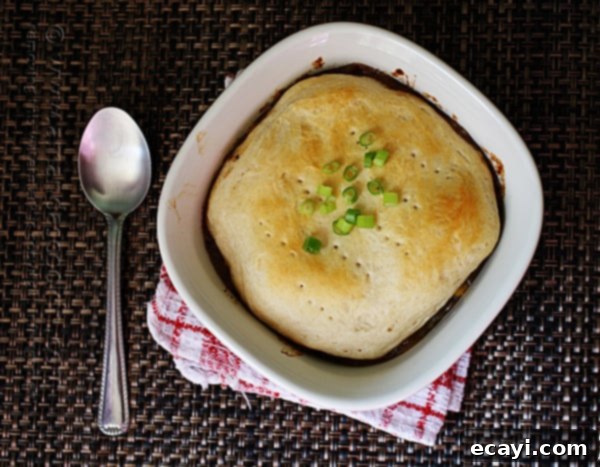
While this recipe provides a fantastic base for a truly exceptional beef stew, feel free to make it your own. If you have a cherished family beef stew recipe, by all means, use it! The beauty of this pot pie lies in its adaptability. And for those looking to reduce carbohydrates, simply enjoy the robust stew on its own without the biscuit topping – it’s equally delicious and satisfying. This flexibility ensures everyone can enjoy this comforting meal, tailored to their dietary preferences. But if you’re looking for a tried-and-true recipe that delivers on flavor and tenderness, then my recipe below is perfect for you.
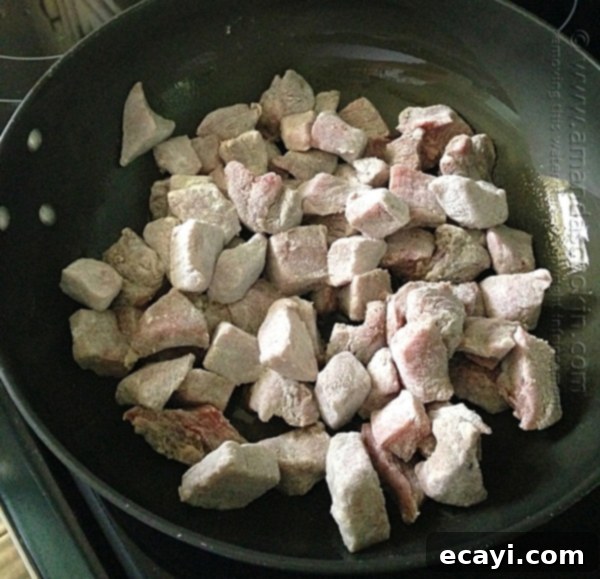
How to Make Homemade Beef Stew Biscuit Pot Pie: A Step-by-Step Guide
Creating this flavorful Beef Stew Biscuit Pot Pie is a straightforward process that yields incredibly rewarding results. Follow these detailed steps to ensure a perfect, comforting meal every time.
Step 1: Prepare and Sear the Beef
Begin by preparing your beef stew meat. Pat the beef dry thoroughly with paper towels. This crucial step helps in achieving a proper sear, which locks in flavor and creates a beautiful brown crust. In a shallow dish, combine the flour, sea salt, freshly ground black pepper, and dried thyme. Dredge the beef stew meat in this flour mixture, ensuring each piece is evenly coated. The flour will help thicken the stew later and contribute to that wonderful crust. Heat the olive oil in a large, heavy-bottomed skillet or Dutch oven over medium-high heat until shimmering. Add the floured beef to the hot skillet, being careful not to overcrowd the pan. Work in batches if necessary to ensure even browning. Sear the meat on all sides until it’s deeply browned and no longer pink. This browning step, known as the Maillard reaction, is essential for developing rich, complex flavors in your stew.
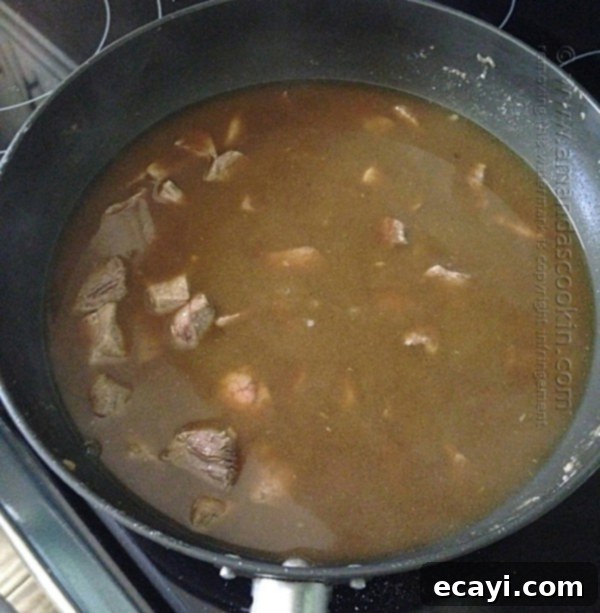
Step 2: Simmer the Stew Base
Once the beef is beautifully browned, carefully add the brewed coffee, beef broth, and water to the skillet. Stir well, scraping up any browned bits from the bottom of the pan – these bits are packed with flavor! Bring the liquid to a boil, then reduce the heat to a gentle simmer. Cover the skillet, leaving the lid partially open to allow some steam to escape, and let it simmer for one hour. During this initial simmering phase, the beef will begin to tenderize, and the flavors will start to meld beautifully. The coffee might seem like an unusual addition, but it deepens the savory notes of the beef without making the stew taste like coffee itself.
Step 3: Add Vegetables and Continue Cooking
After the first hour of simmering, it’s time to introduce your hearty vegetables. Add the chopped potatoes, carrots, and sliced mushrooms to the pot. Stir them into the simmering liquid, ensuring they are well submerged. Continue to cook for another 1 to 2 hours, or until the beef is incredibly fork-tender and the vegetables are soft. The cooking time can vary depending on the cut of beef and your desired tenderness. Keep an eye on the liquid level; if it becomes too thick, you can add a little more beef broth or water. This long, slow cooking process is what makes the stew so rich and comforting.
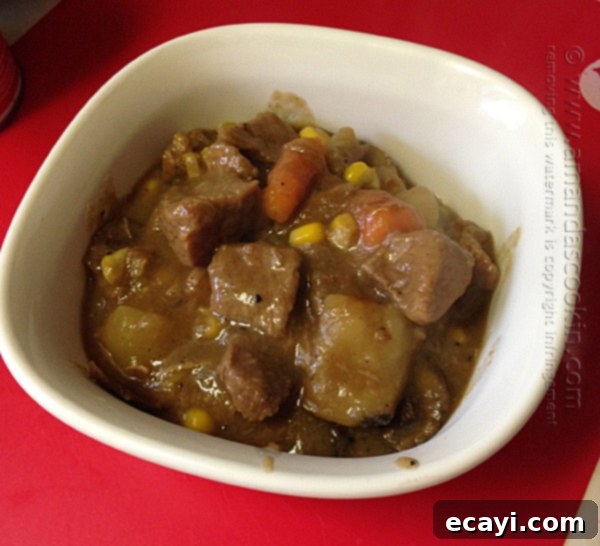
Step 4: Prepare for Baking and Assemble Individual Pot Pies
Once your stew is perfectly tender and flavorful, preheat your oven to 375°F (190°C). Set out 6 to 8 oven-safe individual serving dishes, such as ramekins or small gratin dishes. These individual portions are not only charming but also ensure even baking. Carefully divide the rich beef stew evenly among the prepared dishes. Now for the biscuit topping: open your can of large biscuits. Take one biscuit at a time and flatten it gently with the heel of your hand. This flattens the biscuit slightly, creating a thinner, more cohesive topping that bakes beautifully. Use a fork to poke several holes in the flattened biscuit. This helps steam escape, preventing the biscuit from puffing up too much and ensuring an even bake. Place the flattened, poked biscuit directly on top of the stew in each dish.
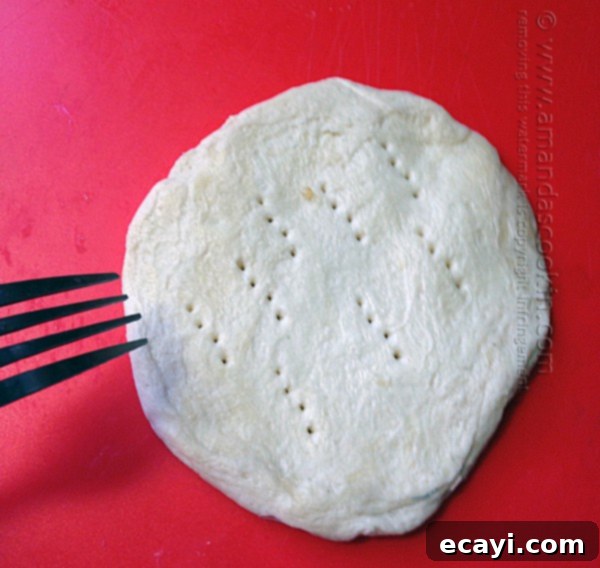
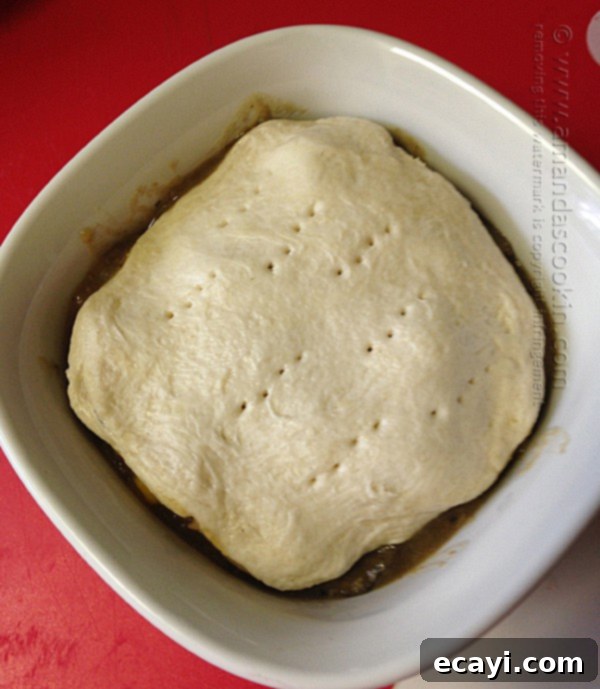
Step 5: Bake to Golden Perfection
Repeat the biscuit flattening and poking process for the remaining dishes until all your individual pot pies are topped. Carefully transfer the dishes to the preheated oven. Bake for 12 to 15 minutes, or until the biscuit topping is beautifully golden brown and cooked through. The exact baking time may vary slightly depending on your oven and the size of your ramekins, so keep an eye on them. Once baked, carefully remove the hot pot pies from the oven. Allow them to cool for a few minutes before serving, as the stew will be very hot. Serve immediately and enjoy the comforting aroma and delicious flavors of your homemade Beef Stew Biscuit Pot Pie!
Tips for Success: Crafting the Perfect Beef Stew Pot Pie
- Quality Meat Matters: Opt for good quality beef stew meat, typically chuck roast or similar cuts, which become incredibly tender with slow cooking. Cut the pieces into uniform sizes for even cooking.
- Don’t Skip the Browning: Searing the beef before simmering is not just for color; it’s crucial for building deep, caramelized flavors that are the foundation of a great stew.
- The Secret Ingredient – Coffee: A small amount of brewed coffee enhances the richness of the beef and adds depth without imparting a strong coffee flavor. Trust me on this one!
- Vegetable Versatility: Feel free to customize the vegetables. Peas, corn, celery, parsnips, or even a handful of spinach can be excellent additions. Add quicker-cooking vegetables like peas or corn in the last 30 minutes of simmering.
- Biscuit Handling: Flattening the biscuits creates a wonderful, more stable crust that won’t become overly puffy. Poking holes allows steam to escape, ensuring a crispier top.
- Individual vs. Large Casserole: While this recipe focuses on individual servings, you can certainly adapt it to a large casserole dish (13×9 inch) for a crowd. Just arrange the flattened biscuits over the entire surface of the stew and bake until golden.
- Season to Taste: Always taste your stew before adding the biscuits. Adjust salt, pepper, and herbs as needed. A dash of Worcestershire sauce or a splash of red wine can also elevate the flavor profile.
Variations to Explore
This Beef Stew Biscuit Pot Pie recipe is wonderfully flexible. Here are some ideas to spark your creativity:
- Cheesy Biscuits: Sprinkle some shredded cheddar or Gruyere cheese on top of the flattened biscuits before baking for an extra layer of flavor.
- Herbaceous Twists: Experiment with different dried or fresh herbs. Rosemary, bay leaf, or a touch of marjoram can add unique notes to your stew.
- Spicy Kick: For a hint of heat, add a pinch of red pepper flakes to the flour mixture or a dash of hot sauce to the stew.
- Vegetable Boost: Incorporate other vegetables like celery, parsnips, or even sweet potatoes for added nutrition and flavor complexity.
- Creamy Texture: For a richer, creamier stew, stir in a splash of heavy cream or a dollop of cream cheese during the last 15 minutes of simmering.
Storing and Reheating Your Pot Pies
These individual beef stew biscuit pot pies are fantastic for meal prepping or enjoying as leftovers.
To store: Allow the pot pies to cool completely. Cover each ramekin tightly with plastic wrap or aluminum foil, or transfer the stew (without the biscuit topping, if possible, to prevent sogginess) to an airtight container. Refrigerate for up to 3-4 days.
To reheat: For best results, reheat the stew in the oven at 350°F (175°C) until warmed through. If you’re reheating a pot pie with the biscuit already on top, you might want to cover it loosely with foil for the first part of reheating to prevent the biscuit from browning too much. You can also scoop the stew into an oven-safe dish, add a fresh flattened biscuit, and bake as directed for a freshly baked top. Alternatively, the stew can be reheated gently on the stovetop or in the microwave.
Frequently Asked Questions (FAQs)
Q: Can I use frozen beef stew meat?
A: It’s best to use fresh or thawed beef stew meat for proper browning and tenderizing. If using frozen, make sure to thaw it completely and pat it very dry before dredging in flour and searing.
Q: Can I make the stew ahead of time?
A: Absolutely! The stew can be prepared up to 2-3 days in advance and stored in the refrigerator. Reheat it gently on the stovetop before dividing into ramekins and topping with fresh biscuits for baking.
Q: What kind of biscuits should I use?
A: We recommend using canned large flaky biscuits for convenience and excellent results. However, you can certainly use your favorite homemade biscuit recipe if you prefer.
Q: Why do you flatten the biscuits?
A: Flattening the biscuits creates a thinner, more even crust that bakes up beautifully golden and crisp. It provides a satisfying texture that complements the stew without being overly bready or crumbly, and it also prevents them from puffing up too much and potentially falling off the ramekin.
Q: Can I add more liquid if the stew gets too thick?
A: Yes, if your stew becomes too thick during simmering, you can add a little more beef broth or water, about 1/4 to 1/2 cup at a time, until it reaches your desired consistency.
This Beef Stew Biscuit Pot Pie is more than just a meal; it’s an experience. It brings together the warmth of a classic stew with the comfort of a golden biscuit, all in an easy-to-manage individual portion. Whether you’re a seasoned chef or a home cook looking for a new family favorite, this recipe promises to deliver satisfying flavors and a cozy culinary hug. Don’t hesitate to give it a try and discover your new go-to comfort food!
 Individual Tamale Pies Individual Tamale Pies |
Sweet Italian Sausage, Pepper and Potato Bake |
Sausage & Pepperoni Pizza Casserole |
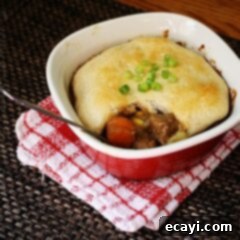
Beef Stew Biscuit Pot Pie
IMPORTANT – There are often Frequently Asked Questions within the blog post that you may find helpful. Simply scroll back up to read them!
Print It
Pin It
Rate It
Save ItSaved!
Ingredients
- 2 lbs beef stew meat
- ¼ cup flour
- ½ teaspoon sea salt
- ¼ teaspoon freshly ground black pepper
- ½ teaspoon dried thyme
- 2 tablespoons olive oil
- ½ cup brewed coffee
- 2 cups beef broth
- 1 cup water
- 2 cups chopped potatoes
- 1 cup chopped carrots
- 1 cup sliced mushrooms
- 1 can large biscuits
Instructions
-
Dry beef stew meat with paper towels. Mix together flour, salt, pepper and thyme and dredge the meat in the flour mixture.
-
Heat olive oil in large skillet over medium high heat. Add meat to skillet brown on all sides until no longer pink.
-
Add coffee, beef broth and water and stir well. Bring to a boil; reduce heat and simmer covered, with lid partially open, for one hour.
-
Add vegetables and cook another 1-2 hours, until meat is fork tender.
-
Preheat oven to 375 F. Set out 6-8 oven safe individual serving dishes. Divide stew amongst dishes. Flatten a biscuit with the heel of your hand and poke it several times with a fork. Place the flattened biscuit on top of the stew. Repeat for the remaining dishes. Bake for 12-15 minutes, or until biscuit topping is golden brown.
The recipes on this blog are tested with a conventional gas oven and gas stovetop. It’s important to note that some ovens, especially as they age, can cook and bake inconsistently. Using an inexpensive oven thermometer can assure you that your oven is truly heating to the proper temperature. If you use a toaster oven or countertop oven, please keep in mind that they may not distribute heat the same as a conventional full sized oven and you may need to adjust your cooking/baking times. In the case of recipes made with a pressure cooker, air fryer, slow cooker, or other appliance, a link to the appliances we use is listed within each respective recipe. For baking recipes where measurements are given by weight, please note that results may not be the same if cups are used instead, and we can’t guarantee success with that method.
